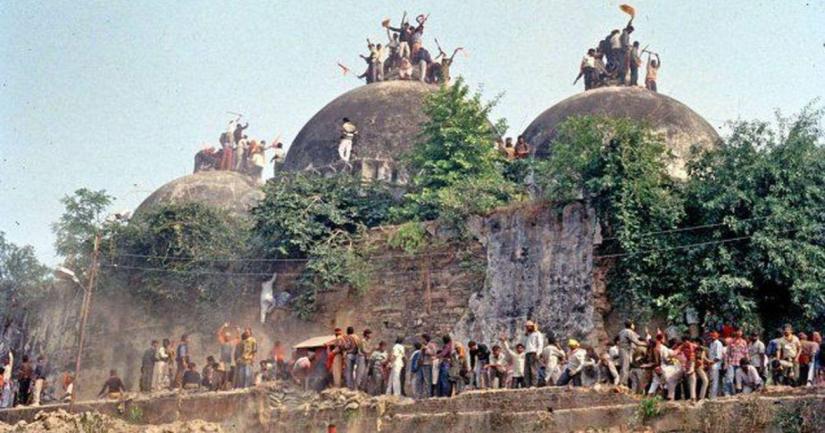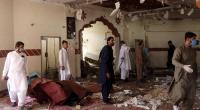 The Supreme Court of India has asked the Hindu parties to present proof of their claim that Babri Masjid was built on the remains of an ancient temple or Hindu religious structure, reports The Hindu.
The Supreme Court of India has asked the Hindu parties to present proof of their claim that Babri Masjid was built on the remains of an ancient temple or Hindu religious structure, reports The Hindu.
“Over the past two millennia, we have seen civilisations settle and resettle on river banks. They have built upon pre-existing structures. But prove that the alleged ruins or demolished building [on which Babri Masjid was built] was religious in nature,” Justice DY Chandrachud asked senior advocate CS Vaidyanathan, who is appearing for the Ayodhya deity, Ram Lalla Virajman, on Friday (Aug 16).
According to the Hindu, Justice SA Bobde asked Vaidynathan to buttress his arguments that the structure was a temple and that too one dedicated to Hindu Lord Ram.
Vaidyanathan responded by referring to the Archeological Survey of India (ASI) excavation report that the structure found underground dated back to the second century BC was massive in circumference with a large number of pillars endowed with sculptures, plastered walls and circular shrine, reports the English daily.
The Masjid was not built on vacant or agricultural land, but on a pre-existent structure which was at the time either in ruins or was demolished.
According to the Hindu, Vaidyanathan acknowledged that there was nothing to show that the structure was a temple dedicated to Lord Ram. But the unstinting faith and belief of the people and the “preponderance of probabilities” show that it was indeed a temple for Lord Ram.
Vaidyanathan submitted photographs of sculptures, images, etc, found in the Babri Masjid structure — before it was demolished on Dec 6, 1992 by kar sevaks — indicating that this was in actuality a place of divine sanctity for the Hindus.
The lawyer referred to images on the pillars showing a Garuda flanked by lions.
“Such imagery was in complete contrast to Islamic practices. They [Muslims] have no images of any human or animal [in a mosque]... The imagery, sculptures within the structure [Babri Masjid] show it was not a mosque in the true sense. Such things are not usually seen in mosques,” he submitted.
Merely because Muslims prayed in the Babri Masjid did not give them ownership over it, Vaidyanathan argued.
When a street is used to offer worship, the street cannot be claimed to be a mosque, The Hindu quoted him as saying.
Besides, no Muslim artefacts were found in the excavations.
But Justice Chandrachud asked how the excavated figurines of animals, human forms could be associated with the divine.
“These may be just any human or animal figurines and not necessarily represent anything divine...” Justice Chandrachud observed.
The judge’s remark came after Vaidyanathan took them through over a 100 photographs of objects excavated from the disputed area to prove that it was a holy place for the Hindus for centuries.
He contended that these objects were “not just figures of any human being or animal”.
“They have been interpreted by archaeologists. The findings are based on the interpretation of excavated materials by archaeologists who are trained in the field. Such interpretation should normally be accepted [by the court],” Vaidyanathan argued.
 International
International
31120 hour(s) 37 minute(s) ago ;
Morning 11:32 ; Sunday ; May 05, 2024
India top court wants proof of Hindu temple beneath Babri Masjid
Send
Bangla Tribune Desk
Published : 17:13, Aug 16, 2019 | Updated : 17:51, Aug 16, 2019
Published : 17:13, Aug 16, 2019 | Updated : 17:51, Aug 16, 2019
0 ...0 ...
/hb/
Topics: Top Stories
- KOICA donates medical supplies to BSMMU
- 5 more flights to take back British nationals to London
- Covid19: Rajarbagh, Mohammadpur worst affected
- Momen joins UN solidarity song over COVID-19 combat
- Covid-19: OIC to hold special meeting
- WFP begins food distribution in Cox’s Bazar
- WFP begins food distribution in Cox’s Bazar
- 290 return home to Australia
- Third charter flight for US citizens to return home
- Dhaka proposes to postpone D8 Summit
Unauthorized use of news, image, information, etc published by Bangla Tribune is punishable by copyright law. Appropriate legal steps will be taken by the management against any person or body that infringes those laws.
Bangla Tribune is one of the most revered online newspapers in Bangladesh, due to its reputation of neutral coverage and incisive analysis.
F R Tower, 8/C Panthapath, Shukrabad, Dhaka-1207 | Phone: 58151324; 58151326, Fax: 58151329 | Mob: 01730794527, 01730794528


